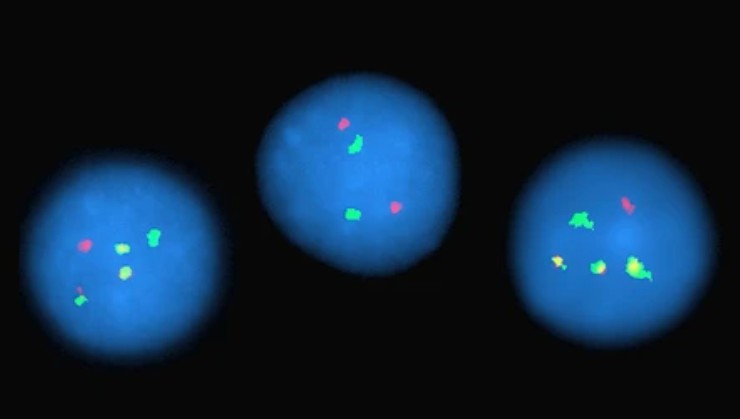Different Types of FISH Probes for Oncology Research
Oncology fluorescence in situ hybridization (FISH) probes represent a groundbreaking molecular cytogenetic technique that has revolutionized cancer research, diagnosis, and personalized medicine. By leveraging the principles of FISH, these probes enable the visualization of specific genetic aberrations and molecular rearrangements associated with various types of cancer.

Introduction of Oncology FISH Probes
Oncology FISH probes encompass a diverse array of specialized molecular tools designed to target and hybridize to specific genetic loci or chromosomal regions implicated in oncogenesis. Within this category, different types of FISH probes play pivotal roles in elucidating the genetic landscape of cancer, including locus-specific probes that target key oncogenes or tumor suppressor genes, enumeration probes that assess gene copy number variations, and fusion probes that detect gene fusions resulting from chromosomal translocations. This precision in targeting specific genetic alterations and chromosomal rearrangements empowers researchers and clinicians to gain comprehensive insights into cancer genetics at the molecular level.
Types of Oncology FISH Probes
- Locus-specific probes. Locus-specific Oncology FISH probes are tailored to target specific genomic regions harboring oncogenes, tumor suppressor genes, or other crucial genes implicated in cancer development and progression. For instance, probes targeting the ERBB2 gene in breast cancer or the MYC gene in hematological malignancies enable the accurate assessment of gene amplifications, providing essential information for treatment stratification and patient management.
- Enumeration probes. Enumeration probes enable the quantification of specific genetic sequences or chromosomal regions, shedding light on gene copy number alterations linked to cancer pathogenesis. By utilizing enumeration probes, researchers can discern gene amplifications, deletions, or aneuploidies, thereby informing the prognosis and therapeutic decision-making for cancer patients.
- Fusion probes. Fusion probes are instrumental in identifying gene fusions resulting from chromosomal translocations, which are prevalent in hematological malignancies and certain solid tumors. By detecting fusion events, such as the BCR-ABL1 fusion gene in chronic myeloid leukemia or EML4-ALK fusion in non-small cell lung cancer, these probes aid in precise cancer subtyping and the selection of targeted therapies.
Oncology FISH Probes in Cancer Diagnosis and Prognostication
The applications of oncology FISH probes in cancer diagnosis are multifaceted. These probes have been extensively employed to identify specific genetic alterations associated with different types of cancer, allowing for accurate classification and subtyping. Furthermore, oncology FISH probes play a crucial role in prognostic evaluation by providing insights into disease aggressiveness and the likelihood of recurrence, thus guiding patient risk stratification and therapeutic planning.
Oncology FISH Probes in Drug Development Research
Oncology FISH probes are instrumental in cancer research and drug development, enabling the characterization of novel genetic alterations, genomic instability, and clonal evolution in cancer. This comprehensive understanding of cancer genetics underpins the discovery and validation of novel therapeutic targets, biomarkers, and predictive indicators, driving innovation in oncology and the development of next-generation cancer therapeutics.
Creative Bioarray Relevant Recommendations
Creative Bioarray is dedicated to pioneering advancements in molecular cytogenetics and genetic analysis, with a particular focus on providing cutting-edge tumor probes.
| Cat. No. | Product Name |
| FON-119 | 13q Tri-color FISH Probe |
| FON-120 | 1p21.2 FISH Probe |
| FON-121 | 1q21.3 + Copy Control 1p12 FISH Probe |
| FON-122 | 1q21.3 FISH Probe |
| FON-123 | 20q12 FISH Probe |
| FON-124 | 5p15.2 FISH Probe |
| FON-125 | 6q21 FISH Probe |
| FON-126 | CDKN2A(9p21.3) + 9q21.11 FISH Probe |
| FON-127 | CDKN2A (p16) 9p21.3 |
| FON-128 | PIK3CA (3q26.3) + Copy Control FISH Probe |
| FON-129 | PHLPP1 (18q21) + Copy Control FISH Probe |
| FON-130 | 7q31 + Copy control 7 Green FISH Probe |
| FON-131 | RET FISH Probe |
| FON-132 | TP73 FISH Probe |
| FON-133 | PTEN FISH Probe |
View our full range of oncology FISH probes and find what you need!